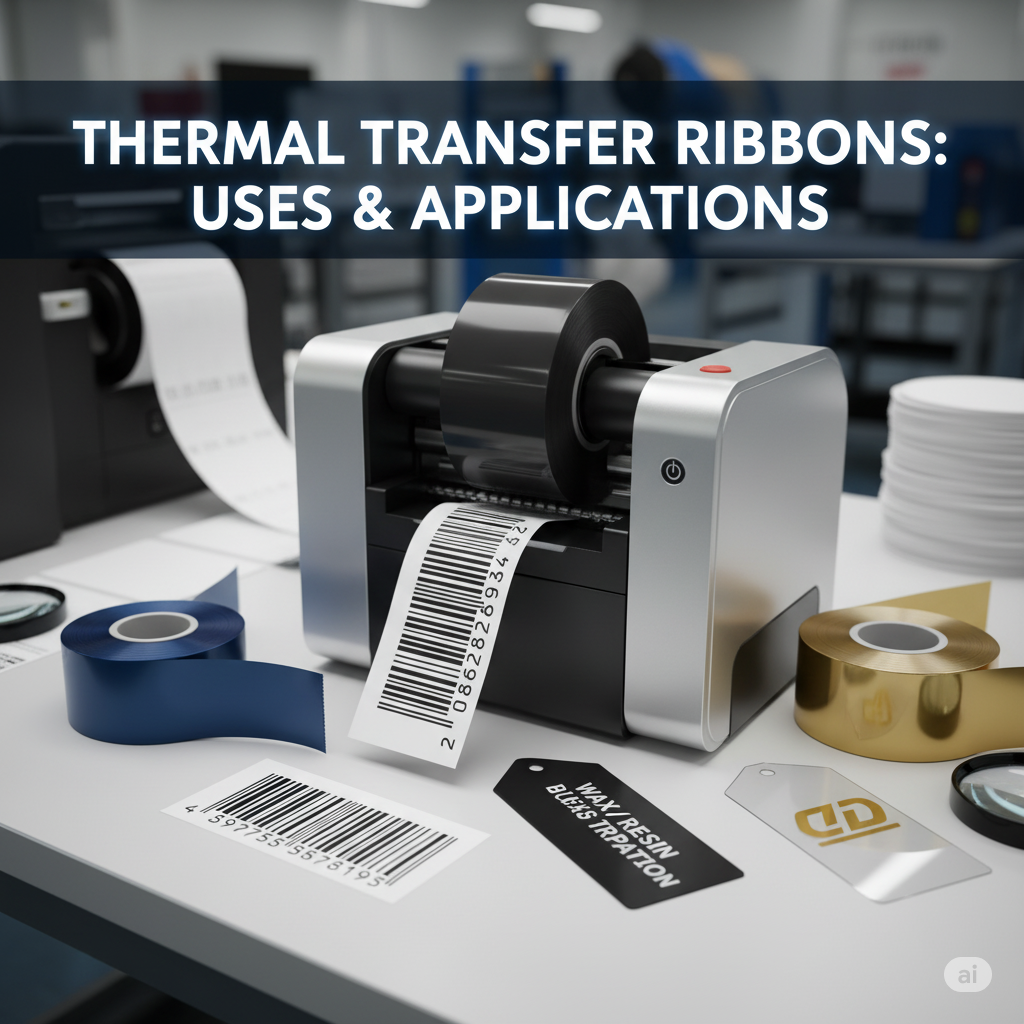
What Are Thermal Transfer Ribbons and Their Uses?
Thermal transfer ribbon is very important in label printing. They are rolls made from thin polyester film that is coated with ink. When heat is applied through the printer head, the ink is transferred onto the label surface, creating text, barcodes, or images.
Understanding the functionality of these ribbons enables you to select the appropriate one for your printing requirements and ensure consistent quality.
Types of Thermal Transfer Ribbons
Each type of ribbon serves a different purpose. Choosing the right one depends on your label material and printing conditions.

-
Wax Ribbons
Wax ribbons are the most common type. They are used for printing on paper-based labels. They offer good print quality for shipping labels, retail tags, and general applications. They are not resistant to chemicals or extreme temperatures. -
Wax-Resin Ribbons
Wax-resin ribbons combine durability and sharpness. They work well on semi-gloss or synthetic materials. They are used for product labels, warehouse tags, and outdoor packaging. These ribbons resist smudging and moisture better than wax types. -
Resin Ribbons
Resin ribbons produce the most durable prints. They are used for polyester or polypropylene labels that must resist chemicals, heat, and abrasion. Industries such as electronics, automotive, and healthcare use resin ribbons for long-lasting identification labels.
How Thermal Transfer Ribbons Work
Thermal transfer printing uses heat to transfer ink from the ribbon onto the label surface. The process involves three parts: the printhead, the ribbon, and the label material.
- The printhead applies controlled heat.
- The ink coating on the ribbon melts.
- The melted ink bonds to the label surface.
The result is a clear, permanent image suitable for scanning and long-term storage.
Common Uses of Thermal Transfer Ribbons
Thermal transfer ribbons are used in many industries because they produce durable prints.
-
Product Labeling
Businesses use ribbons to print product names, barcodes, and expiration dates. This helps with inventory tracking and compliance. -
Shipping and Logistics
Warehouses and distribution centers use ribbons for shipping labels. The prints resist smudging during transport and handling. -
Healthcare
Hospitals use thermal transfer printing for patient wristbands, specimen labels, and medication tracking. The prints stay readable even when exposed to liquids or disinfectants. -
Manufacturing
Factories use resin ribbons to label components exposed to heat or chemicals. This ensures accurate traceability throughout production. -
Retail
Retail stores print price tags, shelf labels, and barcode stickers using wax or wax-resin ribbons. The labels remain clear during storage and sale. -
Electronics
Resin ribbons are used for cable identification and circuit labeling where heat resistance is needed.
Benefits of Using Thermal Transfer Ribbons
- Durability: Prints resist smudging, moisture, and UV exposure.
- Versatility: Works on various surfaces, including paper, film, and synthetic materials.
- Clarity: Produces crisp text and sharp barcodes for easy scanning.
- Longevity: Ideal for labels that must stay readable over time.
How to Choose the Right Ribbon
Choosing the right ribbon ensures quality and efficiency.
- Match the ribbon type to your label material.
- Check printer compatibility before purchase.
- Consider the environment where labels will be used.
- Run a short test before printing large batches.
Maintenance Tips
To maintain print quality, clean the printhead regularly and handle ribbons with care. Store them in a cool, dry place to prevent ink degradation. Avoid touching the inked surface.
Why It Matters
Using the correct thermal transfer ribbon ensures your labels stay readable and professional. It reduces waste and prevents reprinting. Businesses that handle large volumes of labeling, such as e-commerce stores, logistics firms, and manufacturers, benefit from consistent, high-quality prints.
Key Takeaways
- Thermal transfer ribbons transfer ink using heat.
- Wax, wax-resin, and resin are the main types.
- Match ribbon type to label material and usage.
- Clean and store ribbons properly for best results.
Thermal transfer ribbons keep your labeling process reliable and efficient. Whether you print shipping labels or industrial tags, using the right ribbon helps maintain clarity and durability.
